Switzerland is known for its picturesque meadows and snowy mountain peaks.
Hidden in these mountains, along Swiss hiking routes, are rocky cliffs and metal cable ways, made for climbing and scrambling. Via ferrata Switzerland is a great way to experience the thrill of mountaineering, safely attached to a cable.
Via ferrata climbing is an adventure activity that grows in popularity each year. Not as technical as rock climbing, it's a fun and often challenging sport that allows access to difficult-to-reach places. The Alps are riddled with these fixed cableways. You will also find many via ferratas in France and in Italy.
In this via ferrata Switzerland guide, I look at some of the best routes for via ferrata. They are rated according to difficulty level. Some require experience and skill but a few can be done by complete novices. These easier routes make for a fun family activity.
But first, some info to help plan your Swiss climbing adventure...
Planning Your Via Ferrata Climb In Switzerland
When Is The Best Time For Via Ferrata in Switzerland?
The best time to do via ferrata in Switzerland is over Summer (June to October). Outside of this season, it is still possible but snow makes some routes inaccessible and others too dangerous.
You should not attempt via ferrata if rain is predicted. Not only are wet surfaces more slippery to climb, but there is also more chance of rock falls. In many places equipment rental shops will refuse to hire out gear unless there is a long enough window to complete the route.
What Gear Do I Need For Via Ferrata In Switzerland?
To safely undertake via ferrata courses, you will need the following pieces of equipment:
- Via ferrata lanyard set
- Seat Harness
- Climbing helmet
- Shoes with good grip
- Daypack
- Gloves (optional)
This equipment can be rented for the day from shops in nearby towns or mountain huts. If you are more serious about via ferrata, you might want to buy your own via ferrata kit.
For recommendations on buying this equipment, take a look at this guide to via ferrata sets.
Understanding The Via Ferrata Difficulty Rating System
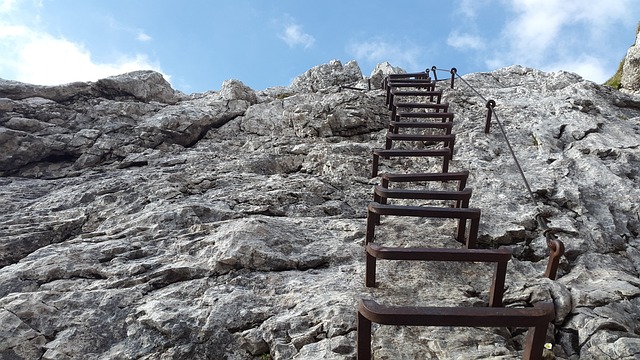
Via Ferratas are rated according to the Hüsler Scale. This is a commonly used K-ating system in many countries around the world, including Italy, Switzerland, and Germany.
Note that ratings are subjective and different people often score the same route differently. Here's a breakdown of each K rating:
K1: Easy. suitable for beginners or those with little climbing experience. The route is flat-steep and rocky. It may have short ladders but is usually climable even without attachments.
K2: Somewhat difficult. The route is steeper and may have some technical climbing elements and short exposed sections.
K3: Moderately difficult. This level requires a good level of physical fitness and The route may include longer and steeper sections, smaller footholds, and longer exposure to heights.
K4: Difficult. This level requires a high level of physical fitness and technical climbing skills.. Expect sustained steep sections, vertical walls and overhangs. pinned footholds are far apart or there is only rock.
K5: Very difficult. This level is only suitable for experienced and highly skilled climbers. Lots of technical sections and long exposure to heights. You opten need to scramble up steep rock with only a metal line.
K6: Extremely difficult. These routes have mostly overhanging cliff with few footholds. There is a lot of steep climbs and potential for long falls. Only for very experienced climbers with, a high level of physical and mental endurance.
7 Exciting Via Ferrata Routes In Switzerland
1. The Eiger - Rotstock Via Ferrata
- Distance: 5km (1.3 miles)
- Expected Time : 2-3 hours
- Difficulty Rating: K2
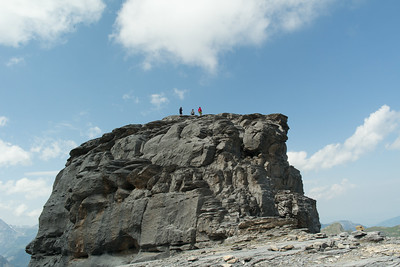
Eiger - Rotstock via ferrata (Photo credit: Martin_vmorris)
This is one of the most famous Via Ferrata routes in Switzerland and offers a fair challenge. The- Rotstock via ferrata offers stunning views of the Eiger North Face.
The Via Ferrata starts at the Eigergletscher train station. The route starts with a steep ascent on a ladder (around 30 minutes), followed by a traverse along a rock face. Climbers will ascend around 400m to a beautiful 360 viewpoint with a wooden cross.
There is a section in between cable lines where you are walking on rocky slopes, with steep drop-offs sometimes covered in snow. Climbers must use extreme caution and some experience in mountaineering is required.
The route finishes with a descent on exposed gravel slope. This takes you back to the Eigergletscher station.
2. Via Ferrata Murren
- Distance: 2.2km (1.3 miles)
- Expected Time : 2-3 hours
- Difficulty Rating: K3
This Via Ferrata is located in the Bernese Oberland region of Switzerland. It is sometimes called the Murren- Gimmelwald Via Ferrata or the Murren fixed rope route. The starts in Murren, you can get here cable car from the nearby town of Lauterbrunnen. You will end this route in Gimmelwald
This short route is partially hiking and gives you views of the Lauterbrunnen Valley. It involves a river crossing on a tightrope as well as suspension bridges and steep ladder climbs.
Murren via ferrata has one section where you are extremely exposed and above 2000ft. If you are going alone, it’s best to have a little experience or go with someone who does
Beginners can join a guided tour. A big perk of going with a guide is that the tour includes a zipline across a ravine. This route is open from the beginning of June until the end of October. There is no entrance fee to access this cableway
3. Daubenhorn Via Ferrata, Leukerbad
- Distance: 8-9km, (1.24 miles) with 2km of steel cables
- Expected Time: 5-8 hours
- Difficulty Rating: K5
This is the longest via ferrata in Switzerland. It is rated as extremely difficult as most of the way is along exposed rock faces. This via ferrata is built onto the mountain’s south-eastern face and takes climbers up all the way to the summit. You will need lots of stamina and a head for heights to complete this one!
To start, you ride to the top of the Daubenhorn cable car from the village of Leukerbad. The first part ‘the small via ferrata’, passes along a series of ladders before reaching the start of ‘the big via ferrata’.
This second section is considered significantly more difficult with a difficult climbing rockface on metal pins. Before reaching this ‘big via ferrata’, there is an option for an alternative descent. If you had difficulty getting through the first part, you should take this detour.
There is a significant risk of rockfalls on this trail which makes it dangerous regardless of experience levels.
From Daubenhorn peak (2942m), it is a fairly straightforward descent across the glacier and down to the Gemmi pass.
4. Tierberglihut via Ferrata
- Distance: 4.3km, (1.24 miles)
- Expected Time: 4 hours
- Difficulty Rating: K3
This is a moderate via ferrata route located near Gadmen, Bern. You reach the start of this trail from Umpol car park, you can get here by bus from Gadmen. Alternatively, it’s about 2hrs drive from Zurich. You can opt to spend a night before or after this via ferrata in the Tirbergli hut.
Most of the trail is not too crazy but there is a section of near-vertical wall. Experienced children, as young as 12, could manage. It would be an okay route for beginners provided they are in good shape and have a head for heights. In this case, it’s advisable to go with a more experienced climber.
This is a loop trail with an ascent of about 930m.
5. Gantrisch Via Ferrata
- Distance: 6.4km, (4 miles)
- Expected Time: 3.5 - 4 hours
- Difficulty Rating: K4
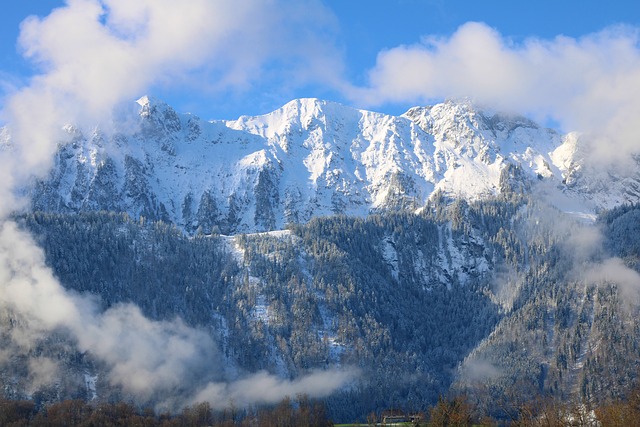
This Via ferrata is located in Gantrisch Nature Park, Bern. 340 vertical meters up steep terrain make this a physically demanding route. The steep rockfaces are not ideal for beginners. But, if you have good arm strength and a climbing technique, it is not the most difficult via ferrata to conquer.
The route begins at the Wasserscheide parking, from here you follow the trail to the Leitere pass. Hike about 45 minutes before reaching the start of the cable.
The via ferrata section takes approximately two hours and includes metal ladders. Along the way, you can see the summits of Eiger, Mönch and Jungfrau to the south. The final part of the via ferrata is the most difficult. This vertical wall is overhanging in parts.
Once you detach from the cables. it’s a 20-minute walk to the summit. The descent along the Letiere pass takes another 45 minutes. You can also go down via Morgenten pass which is slightly longer. The downhill sections get very slippery when wet.
This via ferrata gets very busy on the weekends and holidays. You may only use this route between 15 June - 15 October.
6. Mittaghorn Via Ferrata, Saas Valley - Beginner Friendly
- Distance: 10km (6.2 miles)
- Expected Time: 5-7 hours (depending on fitness and experience)
- Difficulty Rating: K2
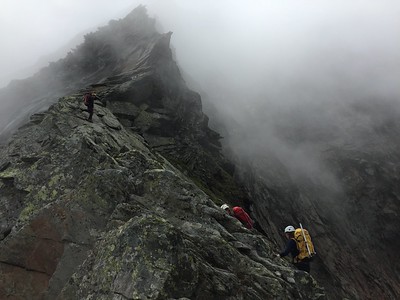
Via ferrata to Mittaghorn (Photo credit: Andy Harbach)
This route to the summit of Mittaghorn is easy enough for first-time via ferrata users yet still delivers an awesome panoramic view. You will get an uninterrupted look at the Saas Valley from 3, 100m above sea level. Imagine standing amongst 13 of Switzerland’s 4000m peaks!
You can choose to start and end this trail from the Britannia mountain hut. Most guided tours start at the Morenia mountain station. To get here, you can catch a train to Visp and then take a bus running to Saas-Fee.
The first part of the trail is hiking only. In about 1.5hrs you reach the start of the via ferrata cables. This cableway is a mix of climbing and scrambling but nothing too crazy. It takes climbers up the ridge all the way to the summit.
7. The Belvédère Via Ferrata, Rhone Valley - Beginner Friendly
- Distance: 1.3km (<1 mile)
- Expected Time: 40 min -1hr.
- Difficulty Rating: K2
This is an easy route that makes for a good introduction to via ferrata. The trail starts between the villages of Nax and Sion. You can take the bus between these towns and hop off at the via ferrata stop. If you are driving your own car to the trailhead, get there early. the small parking fills up quickly.
The trail is easy to follow and well-secured. There are two tightrope bridges and some metal ladder sections which add a sense of adventure and give a taste of more challenging trails. This is a good choice for families with young, adventurous children.
At the top, you get a beautiful view of the Rhone Valley. If you have time, you can walk from here back to Nax or catch a bus. This via ferrata route can be done year-round, so long as there is no snow.
Via Ferrata Switzerland For Beginners: Where Do I Start?
Both the Rhone Valley and Saas Valley in Switzerland are ideal areas for beginners to practice via ferrata. Options 6 & 7 above are both examples of routes that use the cableway but are not too steep and do not require you to have any previous experience with this sport.
For first-timers, It’s always a great idea to join a tour. Beginner-specific via ferrata tours (like this one in the Rhone Valley) are specially designed for those who are interested in trying this adventure activity but don’t know where to start.
With a guided tour, you get exposed to via ferrata routes in a safe environment. You will also learn to properly use a via ferrata kit and gain valuable experience that will prepare you for taking on more challenging routes.

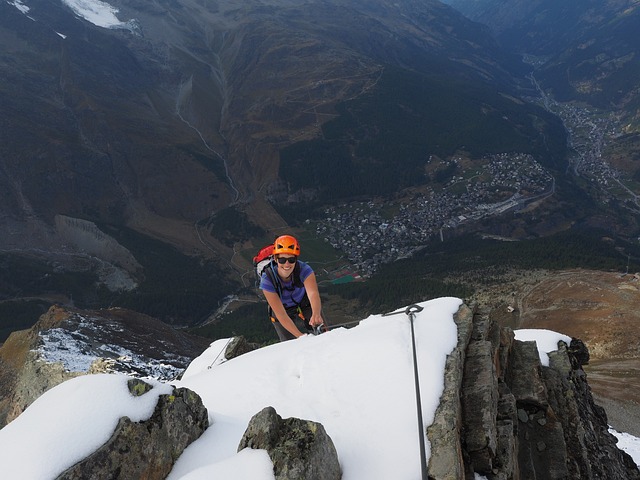
Hi,
Just wondering about the difficulty of the Eiger – Rotstock Via Ferrata. I see you have it down as K4, but other sites I've seen, such as https://www.sac-cas.ch/en/ have it as a K2.
How suitable would you say it is for relative newcomers to via ferrata?
Thanks
Aidan
Hi Aidan, we do tend to err on the side of caution with these types of activities. To be fair, it is more of a K2 with the vertical ‘step’ at the beginning being one of the trickiest parts. Plus there is some steep, non-secured descent areas over rock which could be intimidating to beginner mountaineers. If you have a some experience with the equipment and avoid going when it is wet, I think you will be fine.
P.s. I’ve changed our rating so as not to put people off this fantastic route